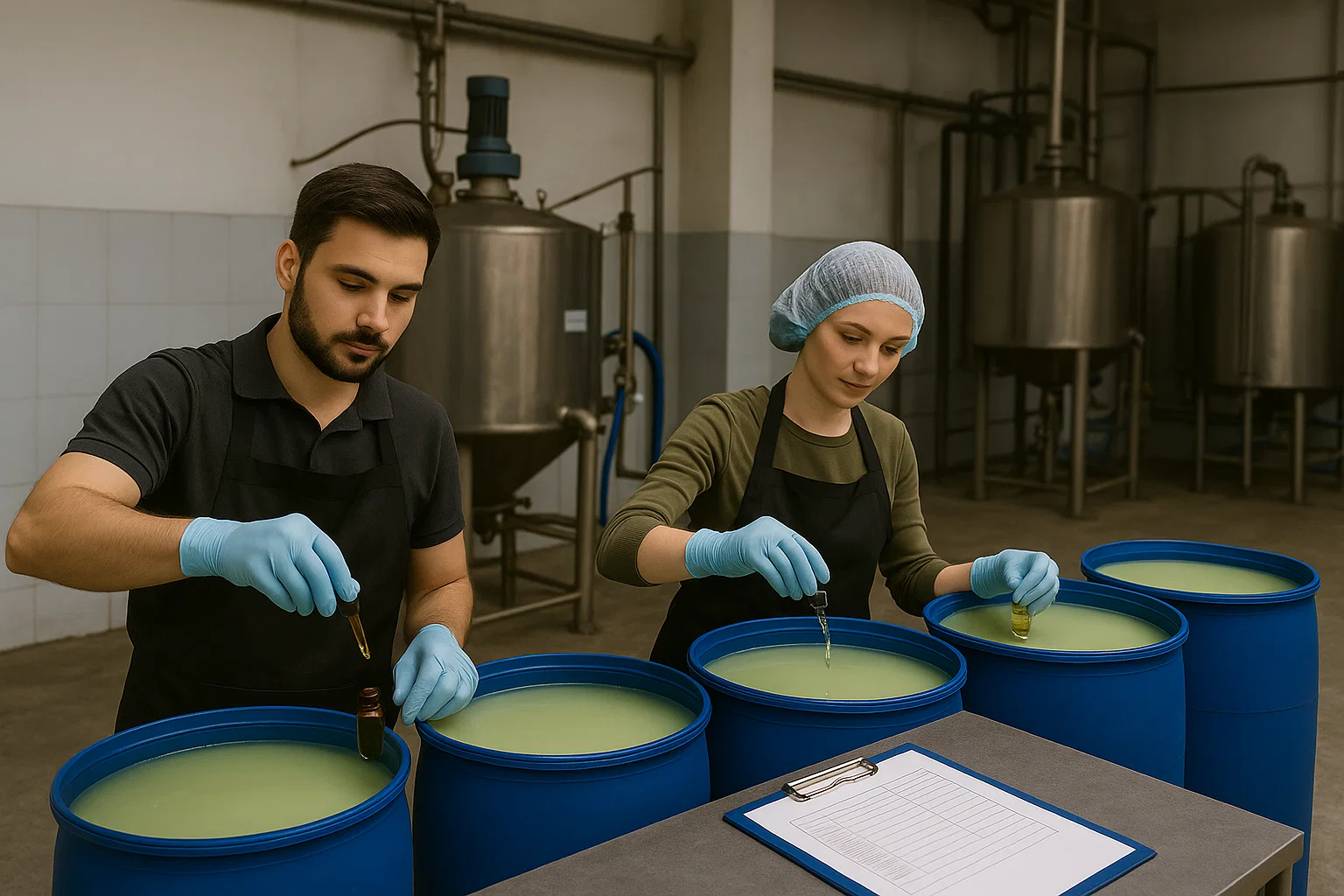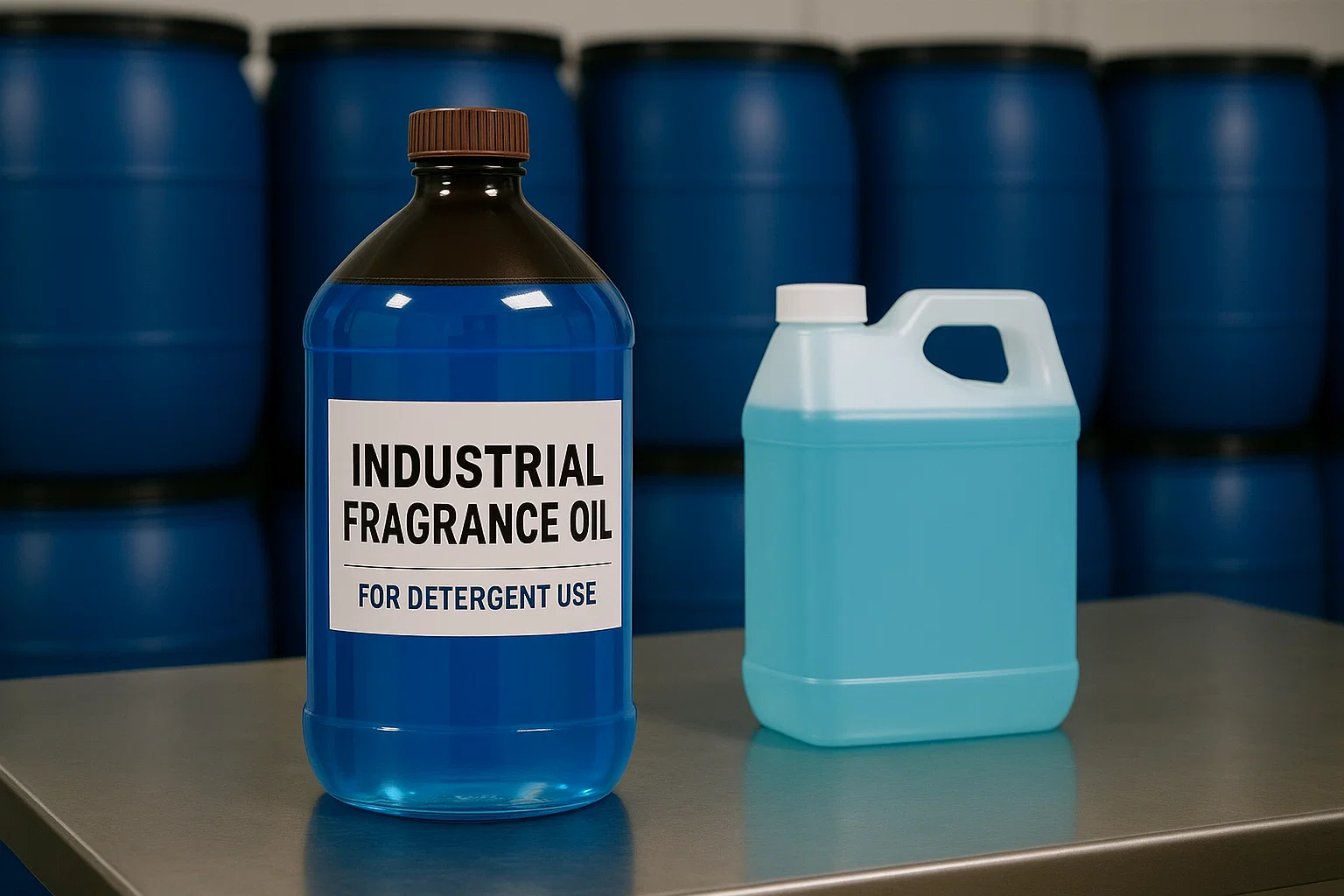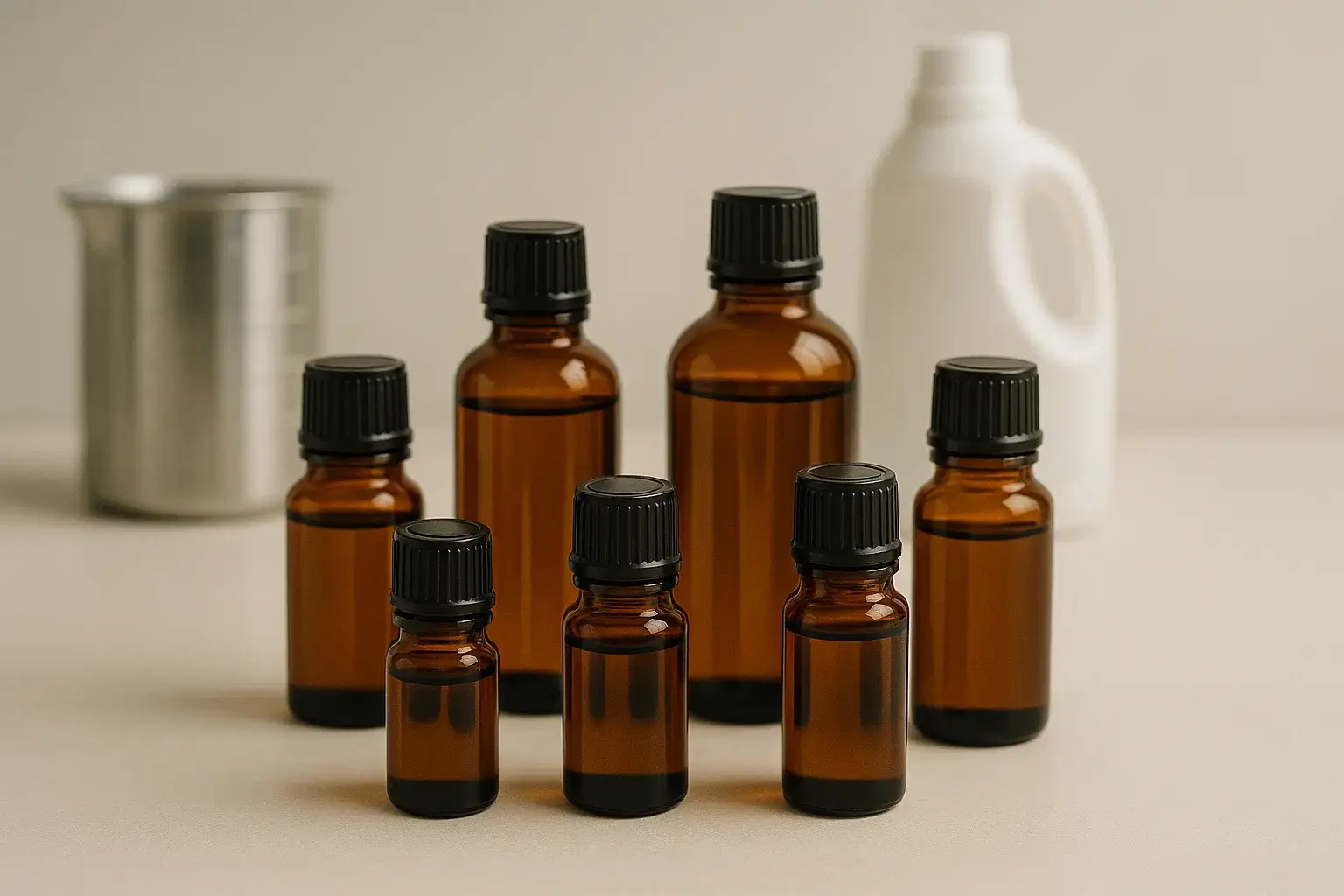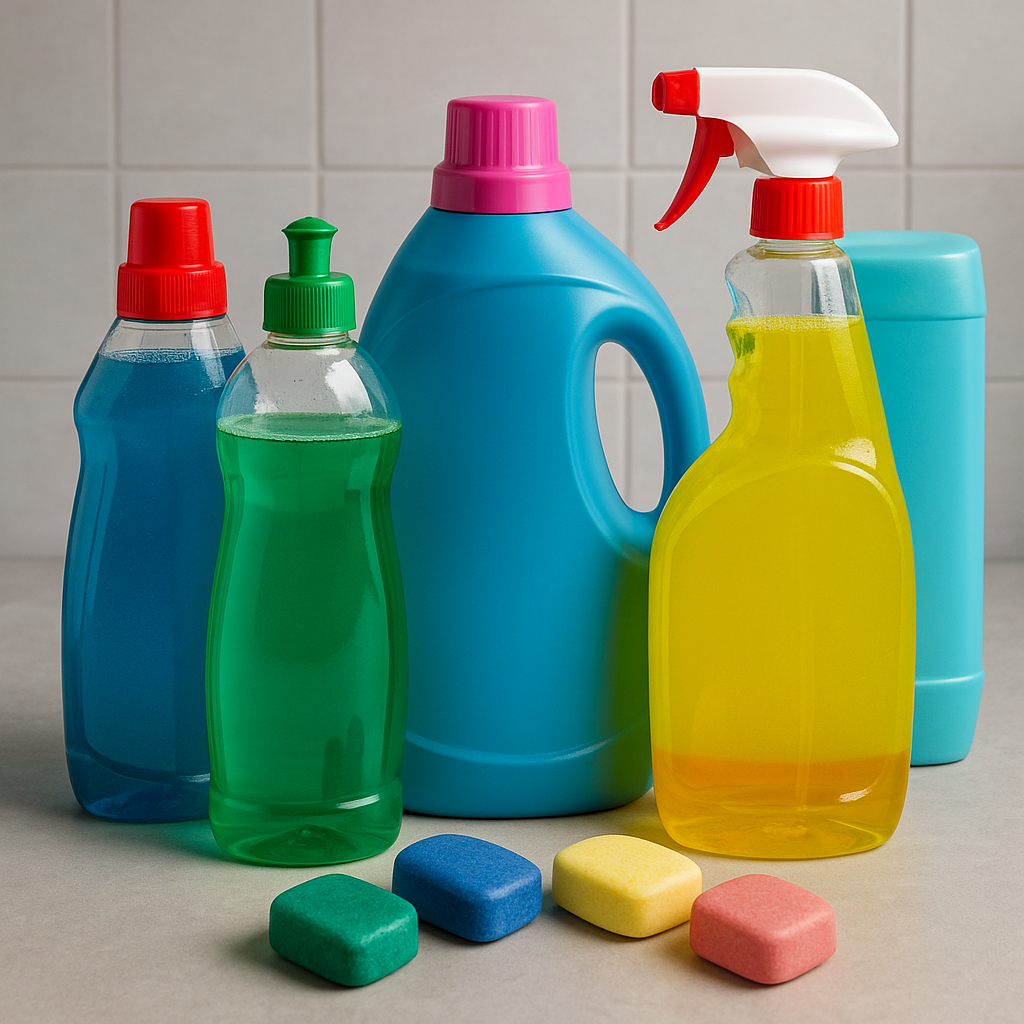In the detergent manufacturing sector, the focus is no longer limited to chemical performance alone. Today, the scent and user experience are critical factors that distinguish a product in a highly competitive market. With increasing consumer interest in formulas that combine effectiveness and comfort, essential oils for detergents have become a reliable component in producing natural-based cleaners that deliver both quality and long-lasting aroma.
Essential oils are among the most versatile additives in the production of liquid, powder, and gel detergents. They are known for their ease of integration, thermal and storage stability, and a wide variety of fragrances that suit everything from floor cleaners to industrial soaps and fabric softeners.
Advantages of Essential Oils in Industrial Detergent Manufacturing
When formulating a competitive detergent product, fragrance selection becomes a strategic step that directly impacts the customer’s first impression—and therefore, repeat purchase behavior. This is where essential oils for detergents prove their value as a core ingredient that enhances product quality without compromising chemical functionality.
Key Technical and Commercial Benefits:
High Fragrance Stability
Essential oils offer excellent durability in liquid, gel, and powder formulations, maintaining their aroma even under extended storage and temperature fluctuations. This ensures that the fragrance remains present after application and use.
Safe and Compatible Composition
Most essential oils designed for detergents are water-dispersible or emulsifiable, allowing for easy integration into the base formulation without complex stabilizers.
Versatile Scent Portfolio
Oils are available in various scent profiles to match different applications—be it disinfectants, laundry detergents, air fresheners, or floor cleaners—allowing manufacturers to create multiple products under the same brand with distinct aromatic identities.
Customizable Intensity
Fragrance strength can be adjusted based on the target market—whether for heavy-duty commercial use or mild domestic products—giving producers greater flexibility in product positioning.
Types of Essential Oils Suitable for Detergents and Their Industrial Applications
Selecting the right essential oil isn’t just about fragrance preference—it must be based on technical factors like chemical stability, thermal tolerance, and compatibility with the detergent’s function. In detergent manufacturing, essential oils for detergents are both a technical and commercial tool that helps define the product’s sensory experience and market appeal.
Here are some commonly used oils in the industry, along with their optimal applications:
Lavender Oil
Widely used in floor cleaners, liquid soaps, and surface sprays, lavender offers a calming, clean aroma ideal for home and hospitality products.
Peach Oil
Light and soft, this oil is suited for fabric refreshers, household surface cleaners, and products targeting women or families.
Apple Oil
Crisp and fresh, it’s perfect for kitchen and bathroom detergents, conveying a sense of instant cleanliness.
Lemon Oil
One of the most popular choices, lemon oil excels in grease-cutting kitchen cleaners, dish soaps, and general disinfectants due to its sharp, clean citrus profile.
Lemon Bril Oil
Designed to resemble strong, recognizable commercial cleaning scents. It creates an impression of powerful cleaning performance and professional-grade reliability.
Comfort Oil
Ideal for fabric softeners and laundry detergents, this scent adds a warm, cozy feel and enhances fabric freshness.
Blue Downy Oil
A luxurious, deep-clean fragrance that suits high-end cleaning products, especially those aimed at the hospitality sector or premium home care lines.
Each oil can be dose-controlled in manufacturing to suit product specifications and audience preferences. Brands seeking market differentiation can strategically offer multiple fragrances under a single product category to appeal to broader consumer segments.
How to Use Essential Oils in Detergent Production Lines
To ensure essential oils for detergents deliver their full potential in the final product, they must be added at precise stages of the manufacturing process, using methods that guarantee consistent distribution and fragrance retention. The approach varies depending on the product type—whether it’s a liquid, powder, gel, or concentrate—as well as the formulation’s pH, viscosity, and active ingredients.
General Guidelines for Industrial Integration:
Timing of Addition
Oils should ideally be added at the final stage of mixing, once the formula has cooled (if heat was applied). This prevents volatilization or degradation of the aromatic compounds due to high temperatures.
Recommended Dosage
Depending on the product type and desired intensity, oil concentrations typically range from 0.3% to 1% of the total formula. Higher levels may be used in high-foam or heavy-use products to improve longevity.
Proper Dispersion
To achieve uniform scent distribution, it’s recommended to pre-dilute the essential oil in a compatible carrier or solubilizer, especially when working with viscous or alkaline formulations.
Pilot Batch Testing
Always conduct a small-scale trial to ensure compatibility between the oil and active ingredients. Check for clarity, color stability, and fragrance consistency, especially in transparent or tinted products.
Packaging Compatibility
Since some essential oils may interact with low-grade plastics, use high-quality, oil-resistant packaging to prevent leaks or degradation during storage and distribution.
Successfully incorporating essential oils for detergents requires more than just scent selection—it calls for a technically sound integration plan that maintains product consistency, enhances consumer perception, and adds long-term value to the brand.
Essential Oils vs. Synthetic Fragrances in Detergent Manufacturing
In detergent production, the choice between essential oils for detergents and synthetic fragrances is a strategic decision that directly affects the product’s quality, brand image, and consumer loyalty. While synthetic fragrances are widely used due to their lower cost, essential oils are gaining momentum thanks to their clean-label appeal and growing demand for natural ingredients.
Key Comparison Points:
Fragrance Authenticity and Quality
Essential oils deliver a natural, plant-derived aroma that’s often more pleasing and realistic than artificial alternatives. Synthetic fragrances may smell strong initially, but often fade quickly or feel chemically “flat.”
Scent Longevity
Oils such as lavender, lemon, and downy-type blends provide lasting fragrance that remains detectable after rinsing or drying, which enhances product satisfaction and perceived value.
Safety and Skin Compatibility
Synthetic perfumes may contain allergenic or irritating compounds, particularly in hand wash or fabric care products. Essential oils—when used correctly—are a gentler and safer option, especially in products for sensitive users.
Cost vs. Performance
While essential oils tend to be more expensive per kilo, their high concentration and lasting effect mean that lower quantities are often needed. Additionally, “fragrance from natural oils” is a marketing edge that allows for premium pricing.
Marketing and Brand Differentiation
Products scented with essential oils can be positioned in the natural, wellness, or luxury segments, attracting a more discerning consumer base. These products also perform better in markets demanding transparency and sustainability.
Choosing between synthetic and natural options isn’t only a formulation matter—it’s a reflection of your brand’s values and market strategy. For companies seeking long-term differentiation, essential oils for detergents represent an investment in both product performance and consumer trust.
Common Mistakes in Using Essential Oils in Detergent Factories—and How to Avoid Them
Despite the clear benefits of essential oils for detergents, improper use during manufacturing can result in performance issues, unstable formulations, or inconsistent fragrance quality. These mistakes are avoidable when technical teams follow best practices tailored to the nature of essential oils and the chemistry of cleaning products.
Most Frequent Errors in Industrial Use:
Adding Oils at the Wrong Stage
Introducing essential oils too early in the mixing process or during high-temperature phases often leads to fragrance loss or evaporation. Oils should always be added at the final stage, after cooling, to preserve their aromatic integrity.
Using Incompatible Oils for Specific Formulas
Some essential oils may react with alkaline bases or surfactants, resulting in cloudiness, sedimentation, or discoloration. Always perform a compatibility test before full-scale production, especially for transparent or colored products.
Overdosing the Formula
Excessive quantities of oil can cause skin irritation or emulsification issues in the final product. Standard dosing ranges from 0.5% to 1%, and should be carefully calculated according to product type and application.
Using Low-Grade or Non-Industrial Oils
Oils not intended for industrial use—especially those mixed with alcohol or synthetic extenders—can lead to instability, poor solubility, or product separation. It’s critical to source oils from trusted suppliers offering tested, detergent-grade materials.
Neglecting Packaging Compatibility
Some essential oils can weaken plastic containers, especially those made from low-density polymers. Use high-resistance packaging to ensure oil integrity during storage and shipping.
By avoiding these pitfalls, detergent manufacturers can fully harness the advantages of essential oils, ensuring consistent results across production batches while improving customer satisfaction and product reliability.
Industrial Storage Guidelines for Essential Oils: Ensuring Stability and Quality
Proper storage is a critical step in preserving the effectiveness of essential oils for detergents prior to their integration into the production process. Due to their volatile and sensitive nature, essential oils can degrade or oxidize when exposed to heat, light, or air—resulting in fragrance loss, color change, or reduced performance in the final product.
Best Storage Practices in an Industrial Setting:
Use Dark Glass or Metal Containers
Essential oils should be stored in amber or cobalt blue glass bottles, or in industrial-grade stainless steel drums to protect them from UV light and prevent chemical interaction.
Maintain a Cool, Dry Environment
Ideal storage temperature ranges between 15°C and 25°C, away from direct sunlight, heat sources, or moisture. A dedicated storage room with good ventilation is preferred.
Seal Tightly After Each Use
To avoid oxidation or evaporation, containers must be properly sealed immediately after dispensing, even during brief pauses in production.
Label Clearly and Track Batches
Each container should include the oil name, batch number, production and expiry dates, to support traceability and internal quality control—especially when using multiple oils in different formulations.
Store Separately from Reactive Chemicals
Essential oils should be kept away from acids, strong alkalis, or other volatile chemicals to prevent unwanted cross-contamination or chemical degradation.
Implement FIFO (First-In First-Out)
Rotate stock to use the oldest batches first, minimizing the risk of oil deterioration or waste due to expiration.
By following these storage guidelines, manufacturers can ensure that their essential oils for detergents retain their fragrance intensity and chemical integrity—resulting in reliable, high-quality outcomes during production and consistent satisfaction in the end product.
Industrial Workflow for Using Essential Oils Across Multiple Detergent Products
To maximize the value of essential oils for detergents, manufacturers must implement a structured production workflow that defines which oil fits which product, the optimal dosage, and the correct stage of addition. A clear and consistent system increases efficiency, reduces waste, and ensures long-term fragrance consistency across product lines.
Examples of Oil Integration in Different Detergent Types:
Floor Cleaners and General Disinfectants
Oils like lemon or lemon bril are typically used at 0.5% to 0.8% concentration, delivering a sharp and fresh scent associated with cleanliness. These oils are added after surfactant blending and cooling.
Laundry Detergents and Fabric Softeners
Oils such as comfort or blue downy are used at around 0.6% to create a long-lasting, soft fragrance. They’re introduced post-emulsification, just before packaging.
Bathroom and Kitchen Cleaners
Apple or peach oils are ideal for these products, combining freshness and appeal. They can be added at higher dosages for a stronger impact in high-use environments.
Hand Wash and Gel Sanitizers
Lavender oil works well in gentle personal care formulations. Recommended usage is 0.3% to 0.5%, ensuring skin compatibility while maintaining a clean, pleasant scent.
Air Fresheners and Surface Sprays
Any of the above oils can be used depending on target preference, with concentrations ranging up to 1% or more for stronger aromatic performance in spray-based or dry applications.
Execution Tips:
Maintain detailed formulation charts for each product to ensure dosing accuracy and avoid manual errors.
Conduct post-blend scent checks to evaluate the fragrance’s final expression in the complete formula.
Designate separate mixing stations for high-intensity oils to avoid cross-contamination between batches.
Implementing a consistent routine for essential oil integration not only improves product reliability, but also enhances brand identity and simplifies scaling across markets with diverse olfactory preferences.





